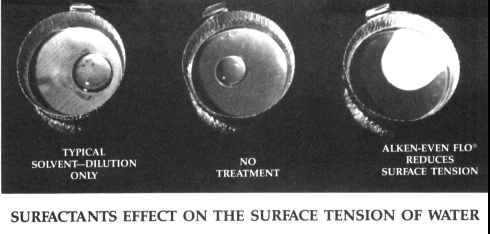Flash Point Test Procedure:
Procedure: Solvent-type products (those that form two distinct layers,
as seen in the previous demonstration) will often have a flash point that
is low enough to be dangerous. If the flash point (sometimes even the fire
point) is at, or below room temperature, that fact can be demonstrated as
follows:
- Pour a small amount of the competing
product into one of the metal dishes.
- Keep another metal dish handy to smother
the fire, should the product ignite, during the next step.
- Pass a lighted match slowly accross the
surface, about ¼ inch above the product.
- Repeat steps 1 & 2 with Alken Even-Flo® to show
that our product will not ignite.
Sludge Dissolving Test Procedure:
- Place a small dab of sludge in the center
of two metal dishes
- Add 3 drops of water to both
- Cover the whole with a heavy non-detergent
motor oil (SAE 30 or equivalent). This simulates conditions at the bottom
of an oil-tank. The motor oil allows the action to be visible.
- Add 2 droppers of competitive treatment
to one dish and 2 droppers of Alken
Even-Flo® to the other.
| The surfactants in Alken
Even-Flo® will begin to attack the sludge and emulsify the water, while
the competitive treatment will show little action other than a slight solubilization
of the sludge. |
- At times, it may be advantageous to hasten
the action by slightly warming the dishes with a lighted match held under
them Be careful using a competing product with a low flash point.
Surface Tension Test Procedure:

- Place a drop of water, about ¼ inch
in diameter, in each of two aluminum weighing dishes.
- To one of these dishes, add a drop of the
competitive product, to the other add a drop of Alken Even-Flo®. Add the products very gently by just bringing
the drop of treatment into contact with the edge of the water drop.
- Most competitive products will simply surround
the water drop and slightly increase its size. Alken Even-Flo® on the other hand, will reduce the surface tension
of the water to such an extent that it will immediately spread over the
entire surface of the dish.
|




